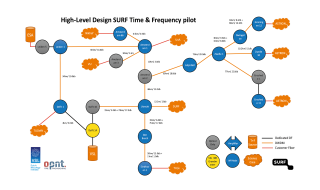Network
SURF Time&Frequency (Pilot)
Doing research accurately
Scientists doing research may have time and/or frequency as variables in their research. For example, when a scientist makes a measurement per second. Or when they study the universe. For these scientists, it is very important that their time and/or frequency is measured very accurately so that their research results are reliable.
So scientists and research centres need very accurate time and frequency signals to make their research data as truthful as possible. This is important for the integrity of experiments, communication, navigation and numerous scientific applications.
Traditionally, a GPS signal is used as the source for the time signal: thus, through a GPS signal, we know what time it is. But for some forms of research, this GPS signal is not accurate enough (+/- 10 ns). Also, GPS signal cannot be received everywhere, e.g. underground, in a shielded lab or between tall buildings. Moreover, researchers may encounter GPS jamming, preventing them from receiving signals. As a result, using the GPS signal as the source for time is not always useful for doing scientific research.
Time and frequency signals
Instead of using GPS signals as a source for time, scientists can use time and frequency signals over fibre optics. These signals are more accurate than GPS signals, for example because they are not obstructed by tall buildings.
The source of these time and frequency signals is the National Metrological Institute 'VSL' in Delft. Through four atomic clocks, VSL realises the Dutch national standard time. This precision time (UTC) and frequency (10 MHz) can therefore provide more accurate research results than using a GPS signal. By means of advanced network equipment, via the SURF fibre-optic network, this precision time and frequency are transported to the research centres. This makes it possible to receive time with a precision of under nanoseconds (<1 ns). By comparison, the time on your computer is precise to the millisecond (<1,000,000 ns). A lot less precise, in other words.
Pilot duration and objectives
In 2018, SURF explored Time and Frequency Transfer (TFT) technologies. In 2021, SURF started testing the White Rabbit Technology (read more on the wiki). In 2023, SURF started a pilot to offer TFT as a standard service to all members. The pilot will study at how SURF, based on the aforementioned White Rabbit Technology, can best add TFT technologies to the existing SURF network.
The pilot will run for two years during which we will further develop TFT services. SURF is doing this in collaboration with the Dutch company OPNT, which specialises in TFT technologies. In the second quarter of 2023, filters were installed on the production network, enabling the first phase of the TFT network roll-out. This first phase, the connection of Delft, Leiden, Amsterdam, Utrecht and Eindhoven was completed in summer 2024. Phase 2, the connection of ASTRON in north-west Netherlands will start in 2025.

- Amsterdam
- Delft
- Den Bosch
- Dwingeloo
- Eindhoven
- Enschede
- Groningen
- Leiden
- Lelystad
- Utrecht
- Zwolle
SURF has established a link between VSL's atomic clocks in Delft and ESA's atomic clocks in Leiden. This link between two different UTC labs is unique. The French BIPM uses this link to contribute to the determination of global UTC time. In other words, this link means we have very precisely the same time all over the world.
ESA has set up the European Space Research and Technology Centre (ESTEC). Inside ESTECT is a UTC time lab. Time is important to ESA for checking the time in their (Galileo) satellites. ESA uses SURF's network to compare their own atomic clocks with those of VSL. VSL also compares their atomic clocks with ESA's. So the time and frequency source is controlled by two highly regarded UTC time labs, which are continuously connected. As a result, we know very accurately what the time is.
In 2022, SURF deployed TFT technologies to support the Delft 'SUPER GPS' project. In it, UTC time is transported with high precision to The Green Village-test site at TU Delft. This precision allowed self-driving cars to drive with 10cm accuracy in an urban environment.
The Dutch Institute for Radio Astronomy (ASTRON) has built and distributed several radio telescopes across the Netherlands and Europe for the LOFAR project. These telescopes look at places very far out in space. Because the measuring equipment is located in different places, it is important to keep track of where in space is being looked at and when it is being looked at. This is because the earth rotates and this rotation can affect the measurement. Because of this rotation, the time of measurement is important to combine (synchronise) the images of the different LOFAR fields into one clear image.
The University of Amsterdam is working in the European consortiumiqClock, in the Amsterdam Science park, on the next generation of portable optical quantum clocks. These clocks use lasers made from strontium atoms at an extremely accurate frequency as the source of time. To build a good clock, it must be possible to test it by comparing it with another good clock.
The UVA uses the SURF Time&Frequency frequency signal to test whether the clock works in the production phase. SURF is working with GEANT on a European TFT network(C-TFN) so that this clock can be tested against another optical quantum clock.
Read the NRC article here:The world's most accurate clocks get even better: they are 1 second out of sync after 14 billion years.